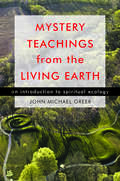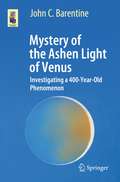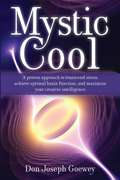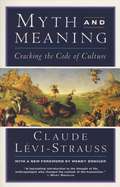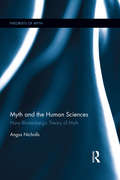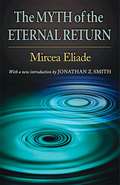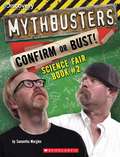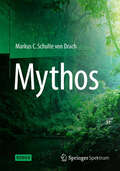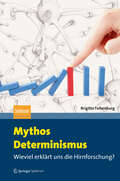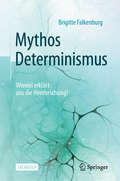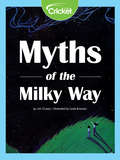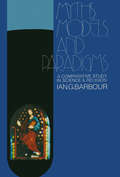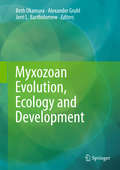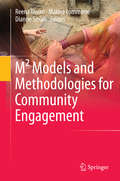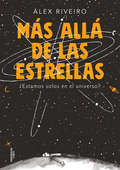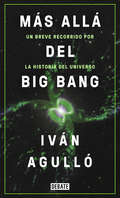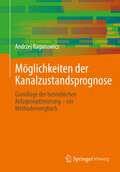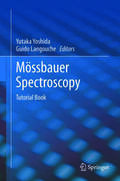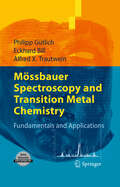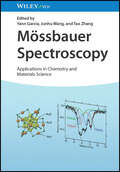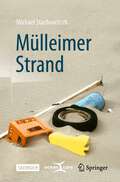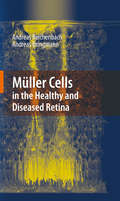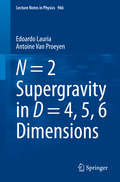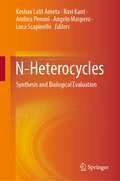- Table View
- List View
Mystery Teachings from the Living Earth: An Introduction to Spiritual Ecology
by John Michael GreerThe authentic mystery teachings are not about quick fixes or easy answers. They offer something far deeper and more meaningfulùa path of personal transformation in harmony with the cosmos on all its levels, from the ultimate heights of spirit to the fragile and beautiful planet on which we live. In Mystery Teachings from the Living Earth, ecologist and Druid initiate John Michael Greer offers an introduction to the core teachings of the mysteries through the mirror of the natural world.
Mystery of the Ashen Light of Venus: Investigating a 400-Year-Old Phenomenon (Astronomers' Universe)
by John C. BarentineThe “Ashen Light” of Venus—a ghostly emission of light from the night side of our nearest planetary neighbor—is among the last unsolved mysteries of astronomical history. In the four centuries since the phenomenon was first reported, highly reputable visual observers of Venus have recorded seeing the Ashen Light, while others have spent a lifetime searching for it without once being convinced that they ever saw it. Is the Ashen Light a trick of the eye? The result of a defective lens? A real scientific event? Occasional references to the Ashen Light are scattered across the literature, yet no work to date has synthesized these records. This book therefore digs deep into the history of the mystery and our latest attempts to understand it, sifting through the clues that might explain whether it is caused by physics, is conjured up by the eye or brain, or a combination of both. This baffling story will appeal to amateur astronomers, hobbyists, and lay readers interested in joining the debate about one of the most elusive observable phenomena ever recorded in the night sky.
Mystic Cool: A proven approach to transcend stress, achieve optimal brain function, and maximize your creative intelligence.
by Don Joseph GoeweyYou possess the most remarkable system in all of biology, the human brain. You have the power to direct it with the most complex set of processes in the universe, the mind. When you use this creative power consciously, you not only actualize the power to excel in whatever you do, you can direct your experience in ways that make life fulfilling and meaningful. As wonderful as this might sound, for many the journey may be anything but. Every major survey shows that the majority of us are plagued by stress and anxiety, which is toxic to the brain. The new science is clear: transcend stress, regain higher brain function, and the mind lights up with creative intelligence. Mystic Cool shows us how to calmly turn our backs on stress and walk in the direction of the brilliant life we were born to live.
Myth and Meaning
by Claude Levi-StraussIn these five lectures, distinguished social anthropologist offers the insights of a lifetime spent interpreting myths and trying to discover their significance for human understanding. This textbook tries to bridge the gap between myth and science. table end
Myth and the Human Sciences: Hans Blumenberg's Theory of Myth (Theorists of Myth)
by Angus NichollsThis is the first book-length critical analysis in any language of Hans Blumenberg’s theory of myth. Blumenberg can be regarded as the most important German theorist of myth of the second half of the twentieth century, and his Work on Myth (1979) has resonated across disciplines ranging from literary theory, via philosophy, religious studies and anthropology, to the history and philosophy of science. Nicholls introduces Anglophone readers to Blumenberg’s biography and to his philosophical contexts. He elucidates Blumenberg’s theory of myth by relating it to three important developments in late nineteenth- and early twentieth-century German philosophy (hermeneutics, phenomenology and philosophical anthropology), while also comparing Blumenberg’s ideas with those of other prominent theorists of myth such as Vico, Hume, Schelling, Max Müller, Frazer, Sorel, Freud, Cassirer, Heidegger, Horkheimer and Adorno. According to Nicholls, Blumenberg’s theory of myth can only be understood in relation to the ‘human sciences,’ since it emerges from a speculative hypothesis concerning the emergence of the earliest human beings. For Blumenberg, myth was originally a cultural adaptation that constituted the human attempt to deal with anxieties concerning the threatening forces of nature by anthropomorphizing those forces into mythic images. In the final two chapters, Blumenberg’s theory of myth is placed within the post-war political context of West Germany. Through a consideration of Blumenberg’s exchanges with Carl Schmitt, as well as by analysing unpublished correspondence and parts of the original Work of Myth manuscript that Blumenberg held back from publication, Nicholls shows that Blumenberg’s theory of myth also amounted to a reckoning with the legacy of National Socialism.
Myth of the Eternal Return: Cosmos and History
by Mircea Eliade Willard R. TraskThis founding work of the history of religions, first published in English in 1954, secured the North American reputation of the Romanian émigré-scholar Mircea Eliade (1907-1986). Making reference to an astonishing number of cultures and drawing on scholarship published in no less than half a dozen European languages, Eliade's The Myth of the Eternal Return makes both intelligible and compelling the religious expressions and activities of a wide variety of archaic and "primitive" religious cultures. While acknowledging that a return to the "archaic" is no longer possible, Eliade passionately insists on the value of understanding this view in order to enrich our contemporary imagination of what it is to be human. Jonathan Z. Smith's new introduction provides the contextual background to the book and presents a critical outline of Eliade's argument in a way that encourages readers to engage in an informed conversation with this classic text.
Mythbusters: Confirm or Bust! Science Fair Book #2
by Samantha MarglesThis fun follow-up book to the successful MythBusters Science Fair Book is packed with more than thirty brand-new experiments for school and at home.
Mythos
by Markus C Schulte von DrachEine Expedition ins Herz des Dschungels. Eine Reise an den Anfang und das Ende des Glaubens. Eine abenteuerliche Auseinandersetzung mit der Religion und der Evolution. Im Jahr 1539 begegnet der spanische Konquistador Juan de la Torre im Amazonasdschungel dem Teufel. Als fast 500 Jahre später die deutsche Schriftkundlerin Nora Tilly im Indienarchiv von Sevilla auf Dokumente des Spaniers stößt, entdeckt sie Hinweise auf einen Inka-Schatz. Doch bald muss sie feststellen, dass sie nicht die einzige ist, die sich auf den Weg macht, um das Gold zu finden. Die irische Journalistin Brea MacLoughlin reist mit einer Delegation katholischer Geistlicher ebenfalls nach Peru, um ein angebliches Wunder in den Anden zu überprüfen. Zu dieser Delegation gehört auch der junge Priester Arnaud d'Albret, der in Südamerika über eine ihm verbotene Liebe hinwegzukommen hofft. Nach dem gewaltsamen Tod seines Mentors schließt d'Albret sich Nora Tilly an. Auch Brea MacLoughlin folgt der Expedition der Schatzsucher. Im Dschungel Perus entdeckt unterdessen der Biologiestudent Francisco Pérez etwas, das eigentlich nicht existieren dürfte: das fünfzehn Millionen Jahre alte Fossil eines Riesenkrokodils, in dessen Schädel eine Pfeilspitze steckt. Der Versuch, dieses Rätsel zu lösen, führt ihn schließlich mit den Schatzjägern aus Europa zusammen. Doch was die Expedition im Dschungel erwartet, ist nicht nur das Gold der Inka. Tief im Wald stoßen sie auf etwas, das ihr Weltbild in Stücke reißt. ......... "Eine abenteuerliche Melange aus Dawkins' Gotteswahn, Indiana Jones und Jurassic Park. Schulte von Drach gelingt, was Dan Brown nie schaffte: den Leser zu fesseln, ohne seinen Verstand zu lähmen. Absolut empfehlenswert!" Michael Schmidt-Salomon, Philosoph und Schriftsteller, Vorstandssprecher der Giordano-Bruno-Stiftung, Autor von "Jenseits von Gut und Böse" "Wie viel Menschenwerk steckt in der Religion? Im Unterschied zum ätzenden Stil neoatheistischer Gotteswahn-Polemik setzt dieses Buch auf eine Strategie à la Umberto Eco: Der Reigen religionskritischer Überlegungen ist eingepackt in eine Rahmenhandlung, deren Spannung - Science-Fiction und Thriller im besten Sinn - den Leser mitnimmt zu den Etappen der intellektuellen Auseinandersetzung." Christian Kummer, Biologe, Philosoph und Jesuit, Professor an der Hochschule für Philosophie in München, Autor von "Der Fall Darwin" _____ Terra X und Theodizee, Evolution und El Dorado, Schatzjagd und Gottessuche - Markus C. Schulte von Drachs neuer Roman entführt Sie auf eine abenteuerliche Reise um die halbe Welt und zurück bis ins 16. Jahrhundert: Von Sevilla, Kismayoo, Florida und Iquitos aus machen sich seine Helden auf den Weg ins Herz des Amazonas-Regenwaldes. Auf der Suche nach dem legendären Inka-Gold, einem unglaublichen Fossil und ihrem Seelenfrieden stoßen ein französischer Priester, eine deutsche Schatzjägerin, eine irische Journalistin, ein peruanischer Biologiestudent und ein türkischer Kreationist auf die Spuren des Matararo. Doch gibt es dieses Wesen überhaupt? Lassen Sie sich von den Abenteuern genauso fesseln wie von den Auseinandersetzungen über Religion und Wissenschaft, die diesen Thriller so außergewöhnlich machen. Folgen Sie den unterschiedlichen Persönlichkeiten auf ihrem Weg, bis am Ende alle gemeinsam vor einer einzigen Aufgabe stehen: zu überleben.
Mythos Determinismus
by Brigitte FalkenburgAus Sicht von Neurobiologen regiert das neuronale Geschehen im Kopf unser Bewusstsein. Als Physikerin und Philosophin hinterfragt die Autorin in diesem Buch die Aussagen von Hirnforschern und stellt fest, dass die Neurobiologie an längst überholten mechanistischen Vorstellungen festhält und dadurch zu Fehlschlüssen über den menschlichen Geist und den freien Willen gelangt. Der Band liefert die Grundzüge einer Wissenschaftstheorie der Hirnforschung und weist damit den Weg zu einem differenzierteren Naturverständnis und Menschenbild.
Mythos Determinismus: Wieviel erklärt uns die Hirnforschung?
by Brigitte FalkenburgAus der Sicht der Neurobiologie regiert im Kopf das neuronale Geschehen. Doch was wissen die Hirnforscher genau über die Mechanismen des Hirngeschehens und ihren Einfluss auf den menschlichen Geist? Dieser Frage geht Brigitte Falkenburg nach. Die Physik hat sich längst vom mechanistischen Weltbild gelöst, in der Neurobiologie bleiben überholte mechanistische Vorstellungen bis heute wirksam. Dabei sind die "mechanistischen" Erklärungen der Hirnforschung ganz anders als ihr Name suggeriert; und wer annimmt, der Geist sei so strukturiert wie die Materie, zieht atomistische und kausale Fehlschlüsse über das Bewusstsein. Falkenburgs Buch möchte die Debatte um Geist und Gehirn, freien Willen und Determinismus endlich davon befreien. Es liefert Grundzüge einer Wissenschaftstheorie der Hirnforschung und eröffnet den Weg zu einem differenzierteren Naturverständnis und Menschenbild. Das beliebte Sachbuch ist für die zweite Auflage vollständig überarbeitet und aktualisiert worden.
Myths of the Milky Way
by Linda Bronson Jim O'LearyOver time, cultures from around the world have given us many different myths about our home galaxy. When you look up at the sky at night, what stories would you tell about what you see?
Myths, Models and Paradigms
by Ian G. BarbourScientist and philosophers have more in common than might first appear, especially when the language used in the two disciplines receives a closer scrutiny. Ian G. Barbour treats three scientific view-points that can clarify the specific nature of religious language. The first theme is the diverse function of language. Science and religion each has its own task and its own applicable logic and language. Religious symbols and their expression in myths imply a perspective and interpretation of human history and experience, directing attention to particular patterns in events. The second theme is the role of models in both scientific and religious language. What the "billiard ball model" of a gas and the biblical model of personal God both achieve is an interpretation of experience, a restructuring of how one sees the world. The third area in which science and religion have a common stake is the role of paradigms. Paradigms are standard examples of scientific investigation which embody a set of assumptions and becomes a research tradition until replaced by other assumptions. Religions has its paradigms, like the covenant of Sinai, which have issued in traditions. Dr. Barbour concludes that scientific and religious language bother offer knowledge of reality based on experience. In determining the appropriate data and criteria for this experience the philosopher of religion can profit greet from the work of the scientist.
Myxozoan Evolution, Ecology and Development
by Beth Okamura Alexander Gruhl Jerri L. BartholomewThis book provides an up-to-date review of the biology of myxozoans, which represent a divergent clade of endoparasitic cnidarians. Myxozoans are of fundamental interest in understanding how early diverging metazoans have adopted parasitic lifestyles, and are also of considerable economic and ecological concern as endoparasites of fish. Synthesizing recent research, the chapters explore issues such as myxozoan origins; evolutionary trends and diversification; development and life cycles; interactions with hosts; immunology; disease ecology; the impacts of climate change on disease; risk assessment; emerging diseases; and disease mitigation. This comprehensive work will appeal to a wide readership, from invertebrate zoologists, evolutionary biologists and developmental biologists to ecologists and parasitologists. It will also be of great practical interest to fisheries and conservation biologists. The identification of key areas for future research will appeal to scientists at all levels.
M² Models and Methodologies for Community Engagement
by Dianne Smith Marina Lommerse Reena TiwariHow can we engage communities? What is empowerment? To what extent should the project process be participatory? How is an outsider-insider relationship handled? How do researchers negotiate with the hegemony of western cultural interpretations? How are organizational and contextual influences handled in a project? What leadership demands do such projects place on researchers? What is capacity building? What are creative leaders and creative communities? How does the researcher journey from their studio to the situation? M² Models and Methodologies for Community Engagement discusses key theoretical constructs -- community engagement, capacity building, and community empowerment -- in order to demonstrate how theory and practice are relevant to the development of forms of community involvement. The book maps the attributes of community based projects by moving beyond simply bringing people together from a variety of disciplines, and taking an approach which is transdisciplinary and applicable across cultures and genres. Here, all people -- including the community -- are ongoing contributors, and can freely move between their own and others' discipline-specific arenas. M² differs from and extends on other works in this field of practice and research, in that its transdisciplinary, collaborative approach positions the community as a particular kind of discipline to create real change in diverse locations and fields of experience. The book is in itself a model of community engagement, as the researchers have formed a community of research and practice for change, and have developed a transformative model for community engagement that is greater than the sum of its parts - hence M². M² offers a valuable resource for students, researchers, academics, practitioners, policy developers and volunteers from the fields of architecture, interior architecture, health, planning, anthropology, education, home economics, communication, political studies and development studies.
Más allá de las estrellas: ¿Estamos solos en el universo?
by Álex Riveiro¿Hay vida en otros lugares del Sistema Solar? ¿Cuántas civilizaciones pueden existir en la galaxia? ¿Nos conoceremos algún día? Desde pequeños, nos fascinan las estrellas y los planetas. En seguida nos preguntamos si en su superficie podría haber criaturas, como tú y como yo, preguntándose si en otros lugares de la galaxia habrá seres como ellos... La avalancha de preguntas es imparable: el ser humano es curioso por naturaleza. Si alguna vez te has hecho alguna de estas preguntas, este libro es para ti. De la mano de Alex Riveiro, autor de Hacia las estrellas. Una breve guía del universo, y creador de Astrobitácora, el podcast de referencia de astronomía en español.
Más allá del Big Bang: Un breve recorrido por la historia del universo
by Iván AgullóUna provocación al intelecto que nos embarca en un viaje fascinante a través del tejido cósmico. ¿Qué fue el Big Bang realmente? ¿El universo es eterno o tuvo un comienzo? ¿Tendrá un final? El lector tiene entre manos una obra que pone las grandes cuestiones del universo al alcance de todos. Con la capacidad de presentar con sencillez temas tan sumamente complejos como la Teoría de Cuerdas y la Gravedad Cuántica de Lazos, Iván Agulló aporta algo de orden al caos infinito de interrogantes que la cosmología enfrenta en la actualidad. Lo hace mediante esta breve historia del universo y de los brillantes teóricos que han revolucionado por completo los cimientos de la ciencia y de nuestro entendimiento de todo cuanto nos rodea. Con una gran profundidad intelectual y filosófica, este libro logrará expandir el universo de ideas que cualquier mente curiosa alberga.
Möglichkeiten der Kanalzustandsprognose: Grundlage der betrieblichen Anlagenoptimierung – ein Methodenvergleich
by Andrzej RaganowiczDieses Buch bietet eine detaillierte Darstellung der Vorgehensweise der Erstellung von Kanalzustandsprognosen sowie eine praxisorientierte Anleitung für die Interpretation der Ergebnisse.
Mössbauer Spectroscopy
by Guido Langouche Yutaka YoshidaTutorials on Mössbauer Spectroscopy Since the discovery of the Mössbauer Effect many excellent books have been published for researchers and for doctoral and master level students. However, there appears to be no textbook available for final year bachelor students, nor for people working in industry who have received only basic courses in classical mechanics, electromagnetism, quantum mechanics, chemistry and materials science. The challenge of this book is to give an introduction to Mössbauer Spectroscopy for this level. The ultimate goal of this book is to give this audience not only a scientific introduction to the technique, but also to demonstrate in an attractive way the power of Mössbauer Spectroscopy in many fields of science, in order to create interest among the readers in joining the community of Mössbauer spectroscopists. This is particularly important at times where in many Mössbauer laboratories succession is at stake. This book will be used as a textbook for the tutorial sessions, organized at the occasion of the 2011 International Conference on the Application of Mössbauer Spectroscopy (ICAME2011) in Tokyo.
Mössbauer Spectroscopy and Transition Metal Chemistry
by Eckhard Bill Philipp Gütlich Alfred X. Trautweinconcentrates on teaching techniques using as much theory as needed.application of the techniques to many problems of materials characterization.Mössbauer spectroscopy is a profound analytical method which has nevertheless continued to develop. The authors now present a state-of-the art book which consists of two parts. The first part details the fundamentals of Mössbauer spectroscopy and is based on a book published in 1978 in the Springer series 'Inorganic Chemistry Concepts' by P. Gütlich, R. Link and A.X. Trautwein. The second part covers useful practical aspects of measurements, and the application of the techniques to many problems of materials characterization. The update includes the use of synchroton radiation and many instructive and illustrative examples in fields such as solid state chemistry, biology and physics, materials and the geosciences, as well as industrial applications. Special chapters on magnetic relaxation phenomena (S. Morup) and computation of hyperfine interaction parameters (F. Neese) are also included. The book concentrates on teaching the technique using theory as much as needed and as little as possible. The reader will learn the fundamentals of the technique and how to apply it to many problems of materials characterization. Transition metal chemistry, studied on the basis of the most widely used Mössbauer isotopes, will be in the foreground.
Mössbauer Spectroscopy: Applications in Chemistry and Materials Science
by Tao Zhang Junhu Wang Yann GarciaMössbauer Spectroscopy Unique and comprehensive overview of versatile applications of Mössbauer spectroscopy in chemistry and material sciences Mössbauer Spectroscopy provides a comprehensive overview of relevant applications of this physical analysis method in chemistry and material sciences. The book shows the versatility of Mössbauer spectroscopy in finding useful information on electronic structure, structural insights, and solid-state effects of chemical systems. A wide range of chemical applications and applied concepts are covered as well as numerous examples, selected from recent literature. To aid in reader comprehension and accessibility, contents are well-structured and divided in different sections covering energy, catalysis, coordination chemistry, spin crossover, sensing, photomagnetism. Edited by prominent scientists in the field and authored by a group of international experts, Mössbauer Spectroscopy covers sample topics such as: Li-ion batteries, catalysts, fuel cells, Fe based silicides and iron phosphates containing minerals Gold clusters and gold mixed valence complexes Molecule based magnets, photoswitchable spin crossover coordination polymers and molecular sensors for meat freshness control With comprehensive coverage of the developments in the technique, Mössbauer Spectroscopy is a beneficial resource for researchers, professionals, and academics in chemistry related fields, such as material science, sustainable environment, and molecular electronics. It can be used by newcomers as well as for educational purposes at the master and PhD levels.
Mülleimer Strand
by Michael StachowitschDieses reich illustrierte Buch ist der ideale Führer zu den Gegenständen, die an den Stränden der Welt herumliegen. Vergessen Sie Muscheln und andere Fauna und Flora. Hier finden Sie, was ein Strandbesucher heutzutage am ehesten antreffen kann: Glas, Plastik, Holz, Metall, Papier, Öl und andere Quellen der Meeresverschmutzung!Mit fast 700 Fotos zeigt dieser Leitfaden die ganze Bandbreite der Müllgegenstände im Meer, die jeweils mit einem Augenzwinkern und einer Prise Humor vorgestellt werden. Darüber hinaus liefert der Autor ausführliche Informationen zu diesen Gegenständen. Sie werden alles Wissenswerte über sie erfahren. Dazu gehören nicht nur ihre Herkunft und ihre Zersetzungsstadien. Sie erfahren, welche Bedrohung die einzelnen Gegenstände für diese wunderschöne Umwelt darstellen, und erhalten Informationen über Präventionsstrategien, Empfehlungen für die Reinigung, alternative Produkte sowie Recycling- und Upcycling-Ideen. Neben dem ästhetischen Aspekt stellt der Müll im Meer auch eine Bedrohung für die Tierwelt, die menschliche Gesundheit und das wirtschaftliche Wohlergehen dar. Dieses Buch gibt Ihnen das nötige Wissen an die Hand, um diese schändlichen und oft gefährlichen Schandflecke zu bekämpfen. Werden Sie ein Stranddetektiv! Bereisen Sie mit dieser ultimativen Strandlektüre die beliebtesten Reiseziele der Welt und helfen Sie mit, diese faszinierenden Umgebungen in ihrer natürlichen Schönheit wiederherzustellen.
Müller Cells in the Healthy and Diseased Retina
by Andreas Reichenbach Andreas BringmannMüller cells may be used in the future for novel therapeutic strategies to protect neurons against apoptosis (for example, somatic gene therapy), or to differentiate retinal neurons from Müller/stem cells. Meanwhile, a proper understanding of the gliotic responses of Müller cells in the diseased retina, and of their protective vs. detrimental effects, is essential for the development of efficient therapeutic strategies that use and stimulate the neuron-supportive/-protective - and prevent the destructive - mechanisms of gliosis.
N = 2 Supergravity in D = 4, 5, 6 Dimensions (Lecture Notes in Physics #966)
by Edoardo Lauria Antoine Van ProeyenThis graduate-level primer presents a tutorial introduction to and overview of N = 2 supergravity theories - with 8 real supercharges and in 4, 5 and 6 dimensions. First, the construction of such theories by superconformal methods is explained in detail, and relevant special geometries are obtained and characterized. Following, the relation between the supergravity theories in the various dimensions is discussed. This leads eventually to the concept of very special geometry and quaternionic-Kähler manifolds.This concise text is a valuable resource for graduate students and young researchers wishing to enter the field quickly and efficiently.
N-Heterocycles: Synthesis and Biological Evaluation
by Ravi Kant Andrea Penoni Keshav Lalit Ameta Angelo Maspero Luca ScapinelloThis book presents an overview of the recent advancements for the synthesis of small- and medium-sized azaheterocycles, including pyrroles, indoles, pyrimidines, pyridines, pyrrolidines, imidazoles, pyrazoles, pyrazolines, lactams, and 1,2,3-triazoles, which are significant scaffolds for compounds with pharmaceutical uses. The book also discusses various properties and performance attributes of azaheterocycles including their bioactivity and synthetic strategies. Given the contents, the book will be a valuable reference for students, researchers, and professionals interested in organic synthesis and medicinal chemistry.

